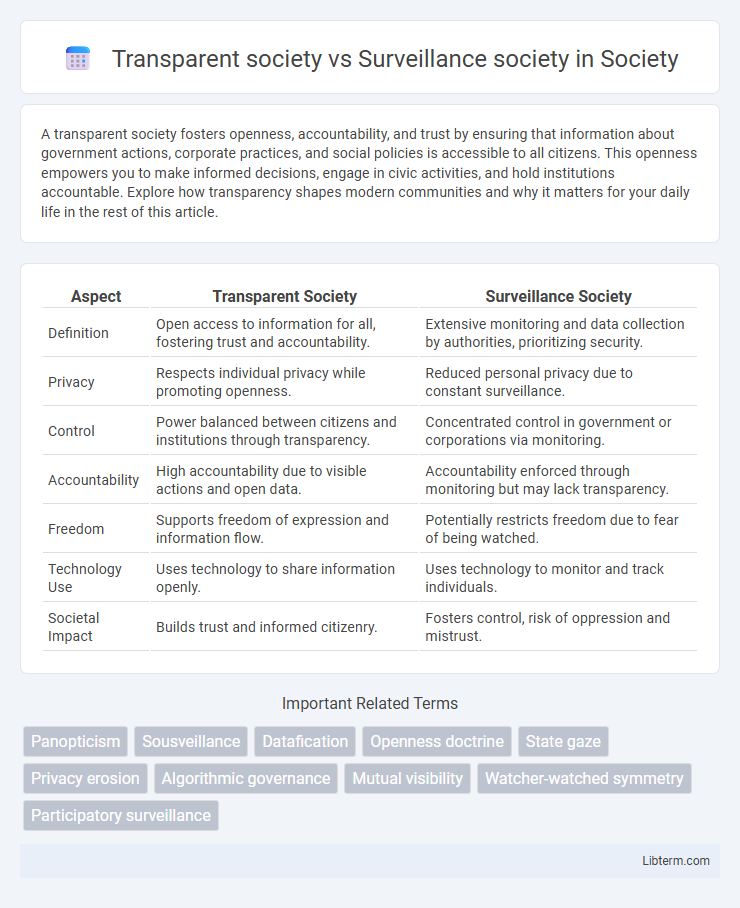A transparent society fosters openness, accountability, and trust by ensuring that information about government actions, corporate practices, and social policies is accessible to all citizens. This openness empowers you to make informed decisions, engage in civic activities, and hold institutions accountable. Explore how transparency shapes modern communities and why it matters for your daily life in the rest of this article.
Table of Comparison
| Aspect | Transparent Society | Surveillance Society |
|---|---|---|
| Definition | Open access to information for all, fostering trust and accountability. | Extensive monitoring and data collection by authorities, prioritizing security. |
| Privacy | Respects individual privacy while promoting openness. | Reduced personal privacy due to constant surveillance. |
| Control | Power balanced between citizens and institutions through transparency. | Concentrated control in government or corporations via monitoring. |
| Accountability | High accountability due to visible actions and open data. | Accountability enforced through monitoring but may lack transparency. |
| Freedom | Supports freedom of expression and information flow. | Potentially restricts freedom due to fear of being watched. |
| Technology Use | Uses technology to share information openly. | Uses technology to monitor and track individuals. |
| Societal Impact | Builds trust and informed citizenry. | Fosters control, risk of oppression and mistrust. |
Defining Transparent Society and Surveillance Society
Transparent society emphasizes openness, accountability, and the free flow of information among citizens and institutions, fostering trust through visible governance and accessible data. Surveillance society prioritizes extensive monitoring and data collection by authorities or corporations to control behavior, often at the expense of privacy and individual freedoms. The contrast lies in transparency promoting empowerment through knowledge, while surveillance enforces compliance through observation.
Historical Context of Transparency and Surveillance
The historical context of transparency dates back to the Enlightenment era, emphasizing open governance and citizen access to information as a foundation for democracy. Surveillance society emerged notably in the 20th century with advancements in technology, such as CCTV and mass data collection, enabling state and corporate monitoring on unprecedented scales. The shift highlights the tension between rights to privacy and demands for accountability in modern states.
Key Differences Between Transparency and Surveillance
Transparency emphasizes open access to information, fostering accountability and trust by allowing individuals to observe and understand organizational or governmental actions. Surveillance involves continuous monitoring and data collection, often without explicit consent, aiming to control or influence behavior through observation. While transparency promotes empowerment through knowledge sharing, surveillance frequently raises concerns about privacy invasion and power imbalance.
Technological Drivers of Societal Change
Technological drivers such as big data analytics, ubiquitous sensors, and advanced AI algorithms enable the shift from transparent societies, where information flows freely and accountability is emphasized, to surveillance societies characterized by pervasive monitoring and data control. The proliferation of Internet of Things (IoT) devices and facial recognition systems facilitates real-time tracking and behavior prediction, intensifying privacy concerns and power asymmetries. Emerging technologies contribute to evolving social norms and governance models by redefining boundaries between public transparency and intrusive surveillance.
Privacy Implications and Ethical Concerns
Transparent societies prioritize openness and accountability, enabling citizens to access government data while maintaining individual privacy protections through strict data use regulations. Surveillance societies often rely on pervasive monitoring technologies that collect extensive personal information, raising significant privacy implications such as data misuse, unauthorized profiling, and erosion of anonymity. Ethical concerns in surveillance societies include potential abuses of power, lack of informed consent, and the undermining of civil liberties, contrasting with transparent societies that emphasize informed participation and respect for personal privacy boundaries.
Impact on Individual Freedoms and Rights
A transparent society promotes openness and accountability, enhancing individual freedoms by allowing citizens to access information and participate in governance without fear of undue privacy invasion. In contrast, a surveillance society prioritizes extensive monitoring and data collection, often leading to restricted rights, increased self-censorship, and potential abuse of power. Balancing transparency with privacy protections is crucial to preserving civil liberties and preventing authoritarian control.
Role of Government and Private Sector
In a transparent society, the role of government centers on fostering open access to information and protecting citizens' rights to privacy, ensuring accountability through clear policies and regulations. The private sector contributes by adopting ethical data practices, enhancing transparency in data collection, and empowering users with control over their personal information. Conversely, in a surveillance society, government agencies often prioritize extensive monitoring and data gathering to maintain security, frequently at the expense of individual privacy, while private corporations may collaborate by providing technological tools that facilitate pervasive data tracking and analysis.
Public Perception and Social Trust
Public perception in a transparent society often fosters greater social trust as open access to information encourages accountability and reduces suspicion among citizens. In contrast, a surveillance society typically generates fear and mistrust due to pervasive monitoring and potential misuse of personal data. Empirical studies show that higher transparency correlates with increased civic engagement and stronger community bonds, whereas surveillance practices correlate with feelings of insecurity and weakened social cohesion.
Case Studies: Transparent vs Surveillance Systems
The Transparent society model, exemplified by Estonia's e-governance system, prioritizes citizen access to government-held data, fostering accountability and trust through open data initiatives and real-time information sharing. In contrast, China's surveillance system utilizes extensive facial recognition and data analytics to monitor public behavior, emphasizing state control and security at the expense of personal privacy. These case studies highlight the fundamental trade-offs between transparency for democratic empowerment and surveillance for authoritative regulation.
Future Challenges and Policy Recommendations
The future challenges of a transparent society versus a surveillance society revolve around balancing privacy rights with security needs amidst rapid technological advances in data collection and AI monitoring. Ensuring robust data protection laws, transparent algorithmic governance, and citizen control over personal information becomes critical to prevent misuse and authoritarian overreach. Policy recommendations include implementing strict privacy regulations, promoting decentralized data management systems, and fostering public awareness to safeguard democratic values in digital societies.
Transparent society Infographic

 libterm.com
libterm.com